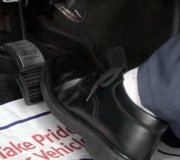2) When bleeding LR and another wheel (don't remember if it was front or rear), I couldn't get the air pocket trapped in the plastic tubing completely out. It would slowly travel back up to the bleeding plug when I had the plug closed and the pedal was being pumped by the assistant for the next push. Is this normal or does it indicate that the bleeder plug isn't closing completely causing the fluid to be sucked back into the cylinder and introducing air? BTW, I installed new bleeder plugs on all four wheels.
3) I was eventually able to get the trapped air completely out of the tubing only after removing the tube, having the brake pumped, opening the bleeder plug and letting fluid squirt out, reattaching the tube, and bleeding the wheel again. When I opened the bleeder plug without the tubing on, it didn't look like the fluid was coming out with pressure. It didn't completely dribble, but I was expecting it to shoot out. Does that mean I need to change cylinder or caliper?
What other things I need to check or replace?
Thursday, April 26th, 2012 AT 7:02 PM



